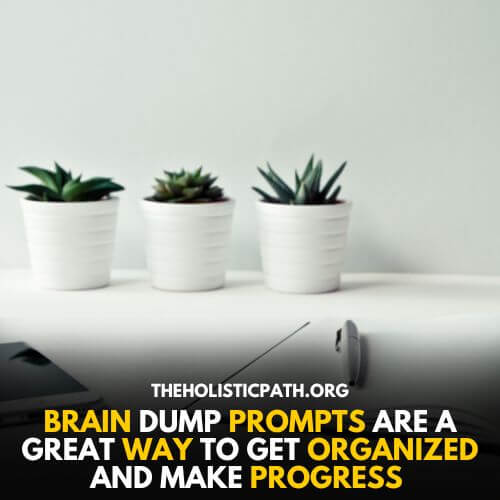Brain dumping is a technique used to help organize your thoughts and ideas. It involves writing down all of your thoughts and ideas on a single topic or project without stopping to judge, criticize or edit them.
This can help free up mental space and make it easier to sort out the clutter in our minds. Brain dumping is particularly useful when we are feeling overwhelmed with too many tasks and responsibilities, want to brainstorm new ideas, or need clarity on how to move forward with a particular project.
This article provides brain dump prompts that will help you get started with brain dumping. Use these as starting points for organizing your thoughts while generating new ones at the same time.
What is A Brain Dump?
A brain dump is a great way to get all of your thoughts and ideas out of your head and onto paper. It’s an effective way to clear your head, organize the information that is in there, prioritize tasks, and help you focus on what matters most. Brain dumps can be used for anything from de-stressing to goal-setting and anything in between.
What is Brain Dump Prompts?
Brain dump prompts are questions or statements that you can use to jumpstart your brain dump. They’re designed to get your mind thinking about the topics and ideas that matter most so that you can be more productive, efficient, and organized. Brain dump prompts can be tailored to your individual needs, so you can use them in any situation.

9 Strong Strategies To Use Brain Dump Prompts
Brain dump prompts are a great way to get organized, focus your energy on what matters most, and make progress toward your goals. To get the most out of your brain dumps, it’s important to first decide what you want to accomplish by creating them.
Here are the strategies to use brain dump prompts:
- Write down 3-5 goals related to the topic/project you are brain-dumping about.
- List out the tasks that need to be completed in order to reach your goals.
- Identify any potential roadblocks you may face and what actions can be taken to overcome them.
- Brainstorm ideas for how you can make the process more efficient or effective.
- List out all of the resources available to you in completing this task (people, tools, websites, etc.).
- Jot down any notes or reminders related to each step of the project.
- Write down any questions you have about this topic/project and how they can be answered.
- Make note of any insights or epiphanies that occur to you during the process.
- Finally, outline a plan of action for how you will complete the task or project.
10 Brain Dump Categories To Get Organized
Brain dump prompts are a great way to organize your thoughts and prioritize tasks in order to achieve success. By using these prompts as a guide, you’ll be able to get more out of each brain dump session and create an actionable plan for the day ahead.
Here are a few significant categories of brain dump:
- Dreams & Goals: What are your long-term goals and dreams?
- Priorities: What tasks/projects need to be completed first?
- Time Management: How can you use your time more efficiently?
- To-Do List: What do you need to get done today, this week, and this month?
- Habits & Routines: What habits or routines do you want to establish in order to be more productive?
- Ideas & Solutions: What ideas or solutions could help with a current problem or project?
- Strengths & Weaknesses: What are your strengths and weaknesses that can help you succeed or hinder you from reaching success?
- Resources & Opportunities: What resources or opportunities can you use to reach your goals?
- Stress & Anxiety: How can you better manage your stress and anxiety?
- Self-Reflection: What have you learned recently, and how do these lessons apply to the present moment?
60 Valuable Brain Dump Journal Prompts To Make You Well-Balanced
Creating brain dump journal prompts is an excellent way to organize your thoughts and prioritize tasks. By writing out your ideas, you can clear your head and set yourself up for a productive day ahead. Here is some brain dump journal prompts to help you get started:
10 Brain Dump Prompts For Life and Family
- What are your biggest dreams and goals?
- How can you better manage stress in your life?
- What habits or routines do you want to establish to reach success?
- What is your definition of success?
- How can you use the strengths and weaknesses in your life to your advantage?
- What ideas or solutions can you use to tackle current projects?
- What relationships are important to you and how can you nurture them?
- How can you use your time more efficiently?
- What resources or opportunities could help you reach success?
- What have you learned recently that could help in the present?

10 Brain Dump Prompts For Work
- What are your career goals and how can you reach them?
- How can you make the most out of each workday?
- Which tasks or projects need to be completed first?
- What activities bring joy to your work and how can you incorporate them more often?
- What strengths and weaknesses do you possess that can help or hinder your success?
- How can you use ideas and solutions to tackle current projects?
- What relationships at work are important to you, and how can you nurture them?
- What resources or opportunities could help you reach success?
- How can you better manage stress in the workplace?
- What have you learned recently that could help in the present?
10 Brain Dump Prompts For Students
- What are your educational goals and how can you reach them?
- How can you make the most out of each study session?
- Which tasks need to be completed first in order to stay on track with your studies to reduce stress?
- What activities bring joy to learning, and how can you incorporate them more often?
- What strengths and weaknesses do you possess that can help or hinder your success?
- How can you use ideas and solutions to tackle current projects?
- What relationships with teachers/professors are important to you, and how can you nurture them?
- What resources or opportunities could help you reach success in your studies?
- How can you better manage stress while studying?
- What have you learned recently that could help in the present and future?
10 Brain Dump Prompts For Personal Growth
- What are your personal growth goals and how can you reach them?
- How can you use your time more efficiently to grow as a person?
- What habits or routines do you want to establish in order to be the best version of yourself?
- What activities bring joy and how can you incorporate them into your daily life?
- What are your strengths and weaknesses, and how can you use them to your advantage?
- How can you use ideas or solutions to make progress on personal goals?
- What resources or opportunities could help you reach success in your personal growth journey?
- How can you better manage stress in order to focus on personal growth?
- What relationships do you have that can help support your personal growth goals?
- What have you learned recently that could help in the present moment?

10 Brain Dump Prompts For Anxiety
- What triggers your anxiety and how can you manage it?
- How does your current lifestyle contribute to your anxiety, and how can you make changes to reduce or eliminate it?
- What strategies can you implement to help manage anxious thoughts?
- What activities bring joy and relaxation and how can you incorporate them into your daily life?
- What relationships do you have that can help support your mental health journey?
- How can you use ideas or solutions to tackle the things that cause anxiety?
- What resources or opportunities could help ease anxiety symptoms or triggers?
- How can you identify and replace negative thoughts with positive ones?
- What self-care techniques can you use to reduce stress and manage anxiety?
- What have you learned recently that could help in the present moment?
10 Brain Dump Prompts For ADHD
- What strategies can you implement to help manage your ADHD symptoms?
- How does your current lifestyle contribute to your ADHD, and how can you make changes to reduce or eliminate it?
- What activities bring joy and relaxation and how can you incorporate them into your daily life?
- What relationships do you have that can help support your mental health journey?
- How can you use ideas or solutions to manage your ADHD symptoms?
- What self-care techniques can you use to reduce stress and take care of yourself with ADHD?
- What resources or opportunities could help ease ADHD symptoms or triggers?
- How can you focus on tasks for longer periods of time and stay organized?
- What have you learned recently that could help in the present moment?
- What measures can you take to improve your time management skills?
10 Brain Dump Prompts For Before Bed
- What activities help you relax and prepare for a restful night of sleep?
- How can you manage stress before bed and create an environment that promotes relaxation?
- What foods or drinks should be avoided in the evening to ensure a better quality of sleep?
- What self-care techniques can you use before going to bed?
- What relationships do you have that can help support your mental health journey?
- What activities can you do during the day to set yourself up for a successful evening routine?
- What strategies or habits can you implement to better manage your sleep schedule?
- How can you use ideas or solutions to make progress on personal goals?
- What have you learned recently that could help in the present moment?
- How can you utilize technology to help make your evening routine more efficient?
Conclusion
Brain dump questions are a great way to start journaling, which can help you declutter your mind and make room for creative solutions. The key is to get everything out in the open so that you can start analyzing it and work towards resolutions.
Once you have written down all your thoughts and feelings, go through each one and think about what emotions arise. Is there anything that stands out? Reflect on how accurate or helpful these feelings may be and whether or not there could be a more productive approach to dealing with them.
Allow yourself time to process this information before making any decisions. Overall, engaging in a brain dump is an excellent starting point for clearing up the mental fog and getting to the root of personal issues.
Frequently Asked Questions
What is Brain Dump Prompts?
Brain dump prompts are a series of questions and ideas designed to help organize your thoughts and create strategies or solutions to problems. They can be used to tackle personal goals, manage mental health symptoms, or establish an evening routine.
What do you write in a brain dump?
1. Goals and objectives
2. Action items
3. Ideas
4. Solutions to problems
5. Notes from meetings or conversations
6. Quotes that inspire you
7. Helpful reminders for yourself
8. Big-picture plans
9. Brainstorming ideas
10. Lists of tasks or projects
11. To-dos for the day, week, or month
12. Notes on business strategies
13. Personal reflections and observations
14. Resources to refer back to later
15. Important facts and figures that you don’t want to forget
16. Ideas for creative projects or initiatives
17. Inspirational or motivational words
18. Contact information for resources you may need in the future
19. Anything else that’s on your mind and needs to get out of your head!
20. Links to websites, videos, and other helpful content related to your current tasks or goals.
What can you do with a brain dump list?
1. Break down the list into smaller, more manageable tasks or goals.
2. Identify what is most important and prioritize accordingly.
3. Use the list to stay organized and on track with your plans and objectives.
4. Create a timeline for completing each item on the list in an orderly fashion.
5. Use it as a reference when planning future projects or tasks.
6. Refer to the list to help create new ideas, solutions, and plans of attack.
7. Revisit the list on a regular basis to ensure that nothing was overlooked or forgotten.
8. Use it as a resource for personal reflection and growth.
9. Use it to help you focus on the most important tasks and stay motivated.
10. Connect the different items on your list to create a cohesive plan of action.
11. Reflect upon what you have accomplished by going through the list and checking off completed items.
12. Find inspiration in the list and use it to help generate new ideas and solutions.
13. Share your list with others who may be able to provide valuable feedback or assistance.
14. Reevaluate the list periodically in order to stay up-to-date with changes or progress.
15. Keep the list handy so that you can review it as needed.
How do you carry out a brain dump?
1. Find a comfortable place where you can write without distractions for about 10-15 minutes.
2. Begin by writing down any and all tasks, ideas, or plans that come to mind.
3. Set an intention before beginning the brain dump process and focus on this goal throughout the exercise.
4. Give yourself permission to write down whatever comes to mind, even if it doesn’t seem relevant or important at the time.
5. Allow yourself to brainstorm and explore ideas without censoring or judging them.
6. Once you have written everything down, take a few minutes to review your list and highlight anything that stands out as particularly important.
7. Use this list as a starting point to create an action plan, timeline, or set of goals that you can work towards.
8. Revisit the brain dump periodically to adjust any changes and review your progress.
9. Share the list with others if it can be helpful for them in some way, or if you need feedback or guidance.
10. Take note of any patterns or similarities you notice in the items on your list, as this may be beneficial for creating future plans and strategies.
How do you untangle your mind with a brain dump?
1. Start by identifying what is causing mental stress or confusion and write it down.
2. Break the issue down into smaller, more manageable pieces and jot them down as well.
3. Ask yourself questions related to each piece of the puzzle in order to better understand how they fit together.
4. Once you have written all of the individual pieces down, begin connecting them together.
5. Identify patterns or trends and see if any solutions start to emerge from these connections.
6. Create a plan of action based on your insights and record it in the brain dump.
7. Reframe any negative thoughts about the issue or task and refocus on the positive aspects of the situation.
8. Ask yourself what resources might be available to help you accomplish this task more easily or efficiently.
9. Take some time to breathe and relax before diving back into your list or plan of action.
10. Revisit your brain dump regularly to ensure that you are still on track and making progress.
11. Celebrate any successes or milestones you reach along the way to keep yourself motivated and inspired.
12. Be open to new ideas and solutions that may arise as a result of your brain-dumping process.
How to do a brain dump ADHD?
1. Start by setting aside a specific time and place to do your brain dump, free from distractions and interruptions.
2. Break the task down into smaller, more manageable chunks and record each item on your list separately.
3. Prioritize tasks or activities according to their importance or urgency.
4. Allow yourself to brainstorm without censoring or judging the ideas that come up.
5. Utilize visual aids such as diagrams, timelines, or color-coding to help you organize and make sense of the information gathered in your brain dump.
6. Reach out for support if needed and connect with others who can offer assistance or guidance.
7. Take breaks throughout the brain-dumping process to give your mind a chance to rest and recharge.
8. Review the list periodically, making adjustments as needed and noting any progress you have made along the way.
9. Reward yourself for completing tasks or achieving goals related to your brain dump.
10. Recognize and celebrate any successes or milestones you reach, no matter how small they may seem.
References:
ALEXA DAVIS (October 28, 2022). Ultimate Brain Dump Trigger List for Journaling. https://ambitiouslyalexa.com/brain-dump-trigger-list/
